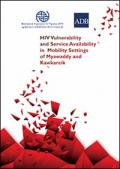Publications - Released in 2015
The relationship between HIV and mobility is widely recognized. While mobility and migration are not risk factors for HIV by themselves, the often harsh, unsafe and isolated conditions surrounding the mobility process can give rise to behaviours strongly associated with increased vulnerability to HIV, while also posing barriers to access to HIV prevention, treatment and care. The dynamics of population movement have evolved in South-East Asia over the last decade, and are in a phase of acceleration due to multiple factors including geopolitical and socio-economic changes, infrastructure development and closer cooperation among ASEAN Member Countries. Whether mobility is internal or cross-border, whether it is voluntary or forced, this increasing population movement generates particular conditions and circumstances that render migrants vulnerable and at risk of HIV infection.
The aim of this study was to assess HIV vulnerabilities and access to HIV health-care services among key affected populations that live or work along the East-West Economic Corridor between Myawaddy and Kawkareik in Kayin State, Myanmar, as well the impact of economic development and increased interconnectivity on these factors.
Downloads
Organizations
- International Organization for Migration (IOM)
- Asian Development Bank (ADB)






